Explore the timeless charm and versatility of wood wall design ideas that can effortlessly transform your living space into a stylish retreat.
Transforming your home into a stylish haven can be as simple as incorporating wood into your wall design. With its natural warmth and versatility, wood offers endless design possibilities, from rustic to contemporary.
This article will delve into various wood wall design ideas, exploring the different types of wood you can use, the various ways you can arrange them on your walls, and how to choose the right finish to match your overall decor.
Whether you’re looking for a dramatic statement wall or a subtle touch of texture, you’ll find all the inspiration and details you need right here.
Rustic Reclaimed Wood Wall
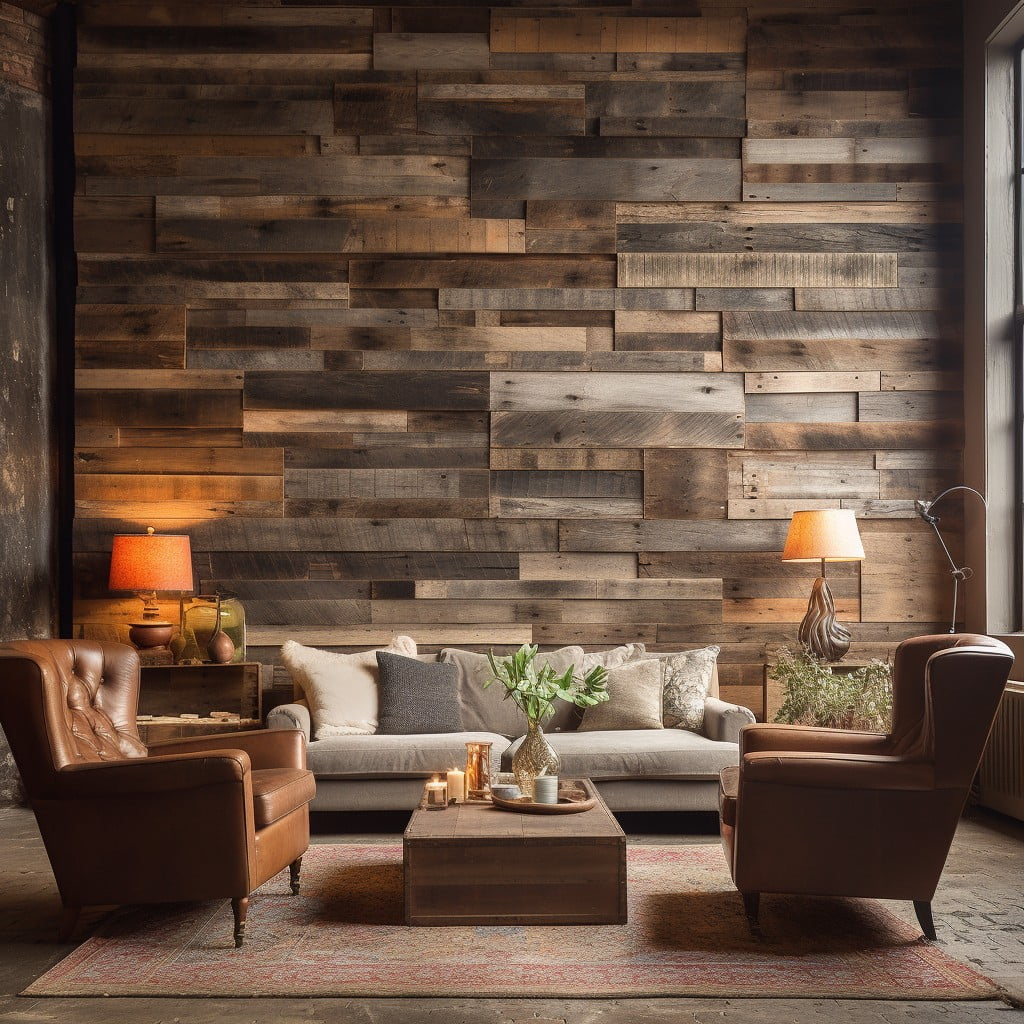
To achieve a beautiful fusion of vintage and contemporary vibes in your dwelling, rustic reclaimed wood can serve as a unique, earthy wall treatment. Here, the essentials to remember:
1. Source of wood: Utilize old barn sidings, pallets, or salvage shops. Its distinct weathered look lends character and warmth.
2. Treatment: Preserve the wood’s natural texture with sealants or oils for authenticity.
3. Wall preparation: A sturdy, smooth surface ensures secure installation. Ensure any wallpaper or loose paint is removed for best results.
4. Installation method: For a professional finish, adhere the reclaimed wood to the wall using suitable adhesive and nails. Always remember to let your materials acclimate to the room’s environment before beginning.
5. Design versatility: Play with various arrangement styles – horizontal, vertical, or diagonal to add an extra layer of visual interest.
Pallet Wood Feature Wall

Loved for both its aesthetics and eco-friendliness, implementing a pallet wood feature wall is a popular choice for a vibrant, textured aesthetic. Enhance any room’s charm by following these key points:
- 1. Material sourcing: Opt for heat-treated pallets to guarantee safety and durability.
- 2. Wall Preparation: Always prime and paint the wall in a neutral shade before installation. It helps to mask any spacing in between the pallets.
- 3. Pallet Treatment: Sand the pallet wood and apply a coat of stain or sealant for a maintained look.
- 4. Installation: Start from the center and work outward, blending different shades of wood for a dynamic wall feature.
By following these steps, one can flawlessly create their customized, mesmerizing wall piece that is surely a conversation starter.
Barnwood Accent Wall
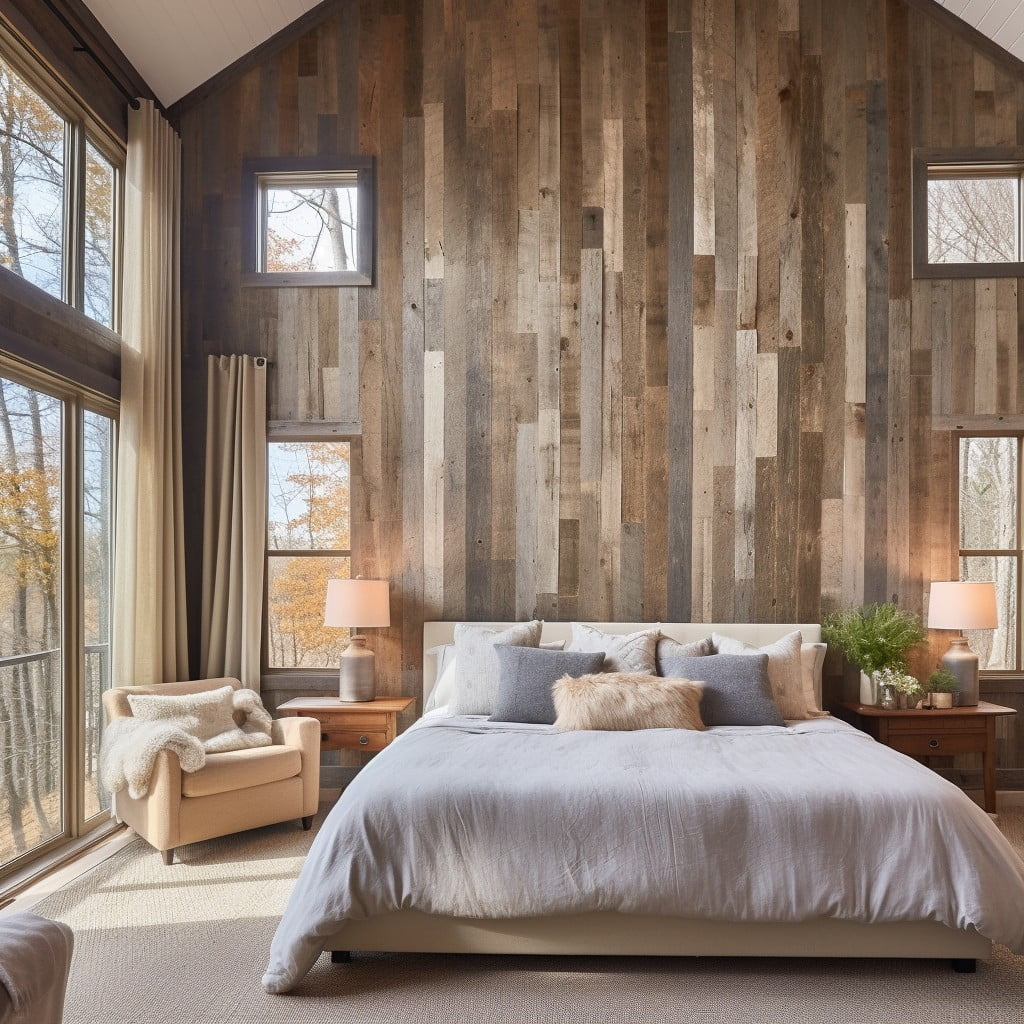
Barnwood, with its rich earthy tones and rugged texture, instantly adds warmth and character. A wall clad in this material can be a striking design feature in any room.
Key points to consider with a Barnwood accent wall include:
- Texture: The uneven surface and unique grain patterns contribute to the rustic charm.
- Color: Natural aging imparts beautiful variations, from deep browns to soft grays.
- Sustainability: Reclaimed barnwood reduces strain on forests.
- Design Versatility: It can comfortably play a striking role in modern, traditional, or rustic interiors.
- Installation: Boards need to be secured to wall studs, ensuring a robust fit.
Despite the worn and weathered look, Barnwood when used strategically, can be a thing of beauty. It can serve as a magnificent backdrop for your artwork, or just by itself, becoming a point of interest in your room.
Dark Stained Wood Paneling

Dark stained wood paneling adds an immediate touch of sophistication to any room. Its sweeping elegance owes a lot to its bold hue and grainy texture, perfectly complementing both contemporary and traditional interiors.
Key Points:
- Color and Finish: Opt for rich tones like walnut or mahogany; they envelop the room in a warm, cozy aura.
- Grain Pattern: A pronounced grain pattern adds texture and depth, effortlessly balancing the darkness of the stain.
- Room Size: Darker shades might make small rooms appear smaller. For such spaces, one accent wall could suffice.
- Light Balance: Natural, ambient and task lighting, when well-used, counterbalance the darkness, encouraging a more inviting ambiance.
- Decor Pairing: Dark paneling pairs well with brighter furniture and decor pieces, striking a stunning contrast.
- Maintenance: Regular dusting maintains its sheen and prolongs its life. Use specifically formulated wood cleaners and avoid harsh chemicals.
Remember, the ultimate goal of dark stained wood paneling is to create an inviting, stylish and sophisticated space.
Staggered Wooden Slats Wall
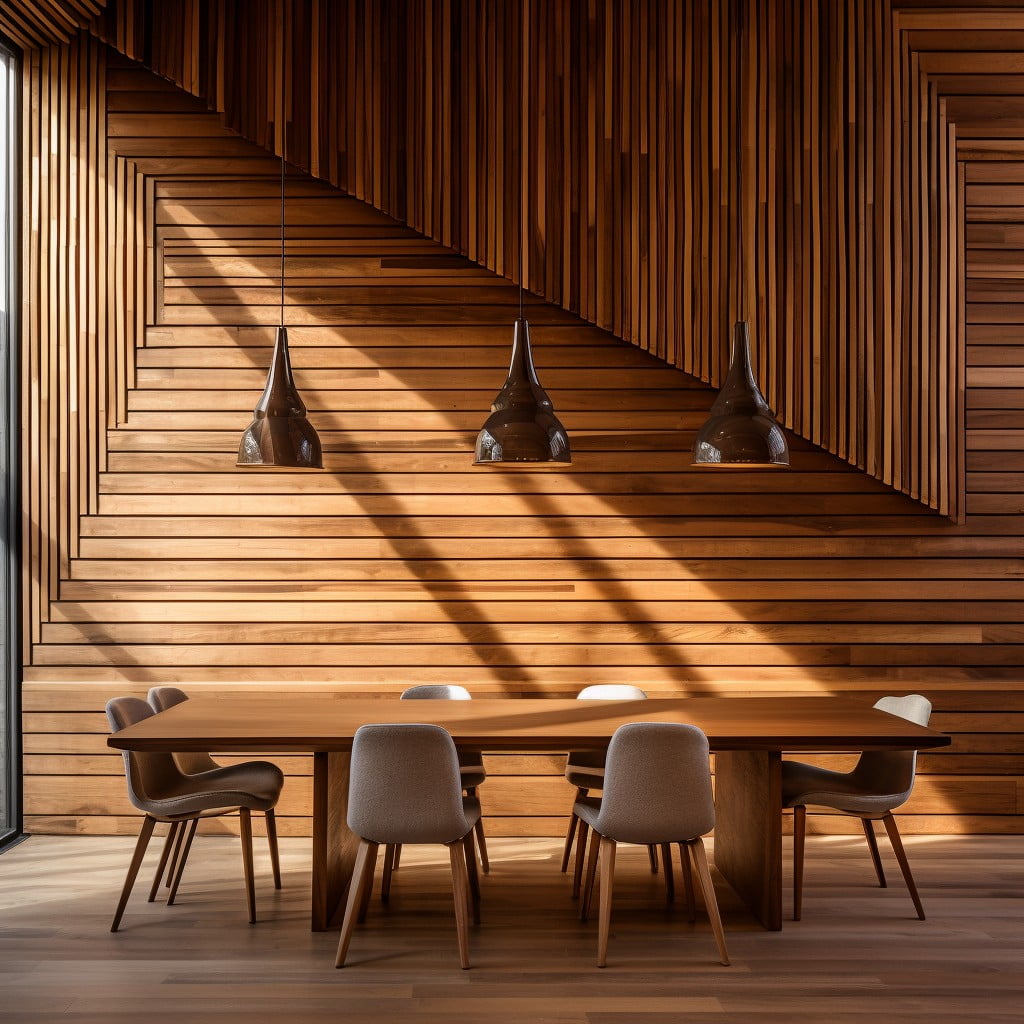
Bearing an unmatched aesthetic appeal, the stylishly staggered wooden slats can bring texture and depth to any space. Here are key takeaway points:
1. Alignment: Staggered wooden slats can be installed in horizontal or vertical alignment. Vertical alignment elongates a room while horizontal alignment broadens it.
2. Natural look: The natural grain and color of the wood breaks the monotony of a room, adding warmth and texture.
3. Light play: The gaps between the slats play with light, creating lively patterns across the room.
4. Wood Choice: Depending on personal style, different wood species offer different colors and durability.
5. Finishing: Protective sealants not only enhance the natural beauty of the wood but also significantly improve its lifespan.
Remember, this design is not just for walls; it is also an excellent choice for ceilings, adding dimension and a dramatic modern look to any room.
Multicolored Wood Panel Wall

Creating a captivating feature, the multicolored wood panel wall incorporates distinct hues and textures, stimulating visual interest and depth.
Here are the key points to achieve this style:
- 1. Variety of Wood: Utilize various types of woods – like pine, oak, walnut – each having unique color tones and grains.
- 2. Color Scheme: Choose a color palette that aligns with the room’s decor – ranging from subtle monochromic to vibrant contrasting hues.
- 3. Wood Treatment: The panels can be painted, stained, or left in their natural state to achieve the desired look.
- 4. Panel Placement: Arrange panels horizontally, vertically, or following a pattern for added dynamism.
- 5. Finish: Consider a matte, semi-glossy, or glossy finish according to the overall room aesthetics.
Geometric Pattern Wood Wall
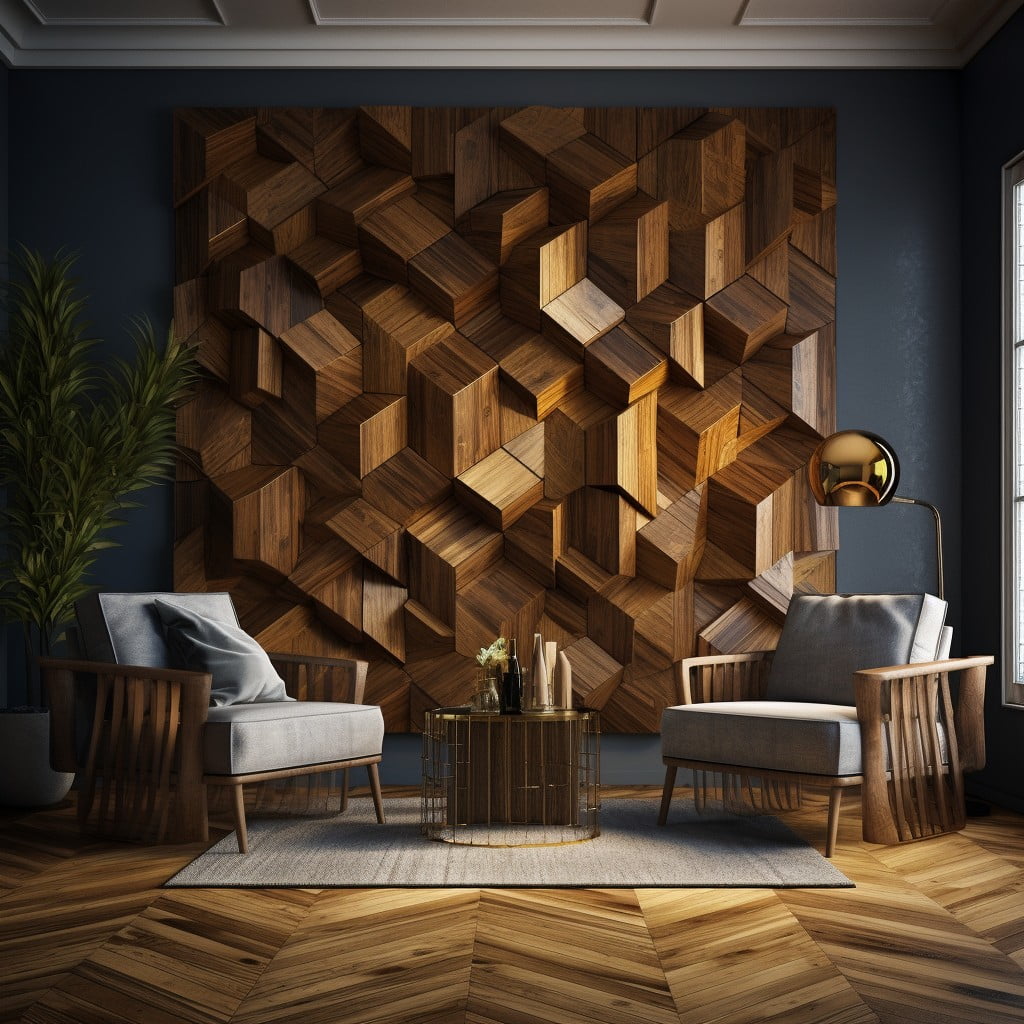
This wood wall idea involves creating eye-catching patterns through the strategic placement of various shaped wood pieces. There are endless opportunities for customization, making it a favorably flexible design. It serves as mesmerizing visual interest to any blank canvas, shifting a space from plain to extraordinary.
Essential Points:
- 1. Different geometric shapes add dimensional appeal. You can go simple with squares and rectangles or experiment with more complex forms like hexagons or trapezoids.
- 2. Opt for contrasting wood shades to make your pattern pop. Mixing and matching dark and light wood grains can create striking visual effects.
- 3. Plan your design in advance. Drawing the schematic on paper or computer prior to starting can ensure you’ve got the accurate cutting measurements and pleasing pattern arrangement.
- 4. Attach securely to the wall. Consider using wood glue and nails, or for larger pieces, utilize sturdy wall anchors.
- 5. Lastly, finishing touches make a big difference. Seal the wood with a clear, protective coating to prolong its beauty and resistance towards the elements.
Distressed White Wood Wall
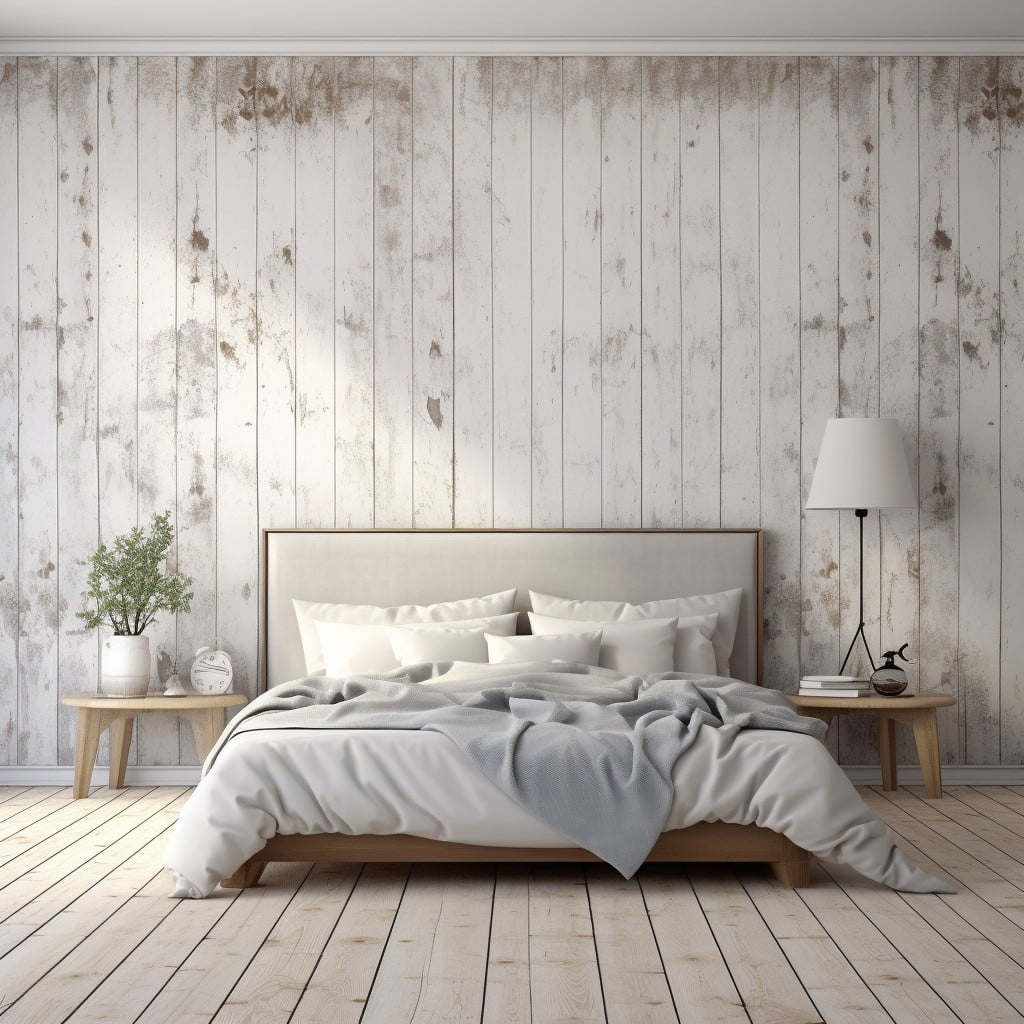
A distressed white wood wall offers a unique blend of rustic charm and contemporary elegance. The rough, weathered texture complements a variety of interior styles, from modern farmhouse to coastal beach house.
Key points:
- Technique: Achieved by sanding and chipping away at the surface of the wood, followed by a coat of white paint, then further sanding to reveal the wood beneath in patches.
- Style flexibility: White color keeps the space feeling airy and bright while the distressed look brings warmth and texture.
- Material choice: Use either genuinely aged wood for authenticity or distress newer wood to achieve the same effect.
- Room compatibility: Works equally well in kitchens, bathrooms, bedrooms or living rooms.
- Decor pairing: Combine with minimalist furniture for a Scandinavian look, or choose distressed or vintage pieces for a shabby chic or farmhouse style.
Niches in Wooden Wall
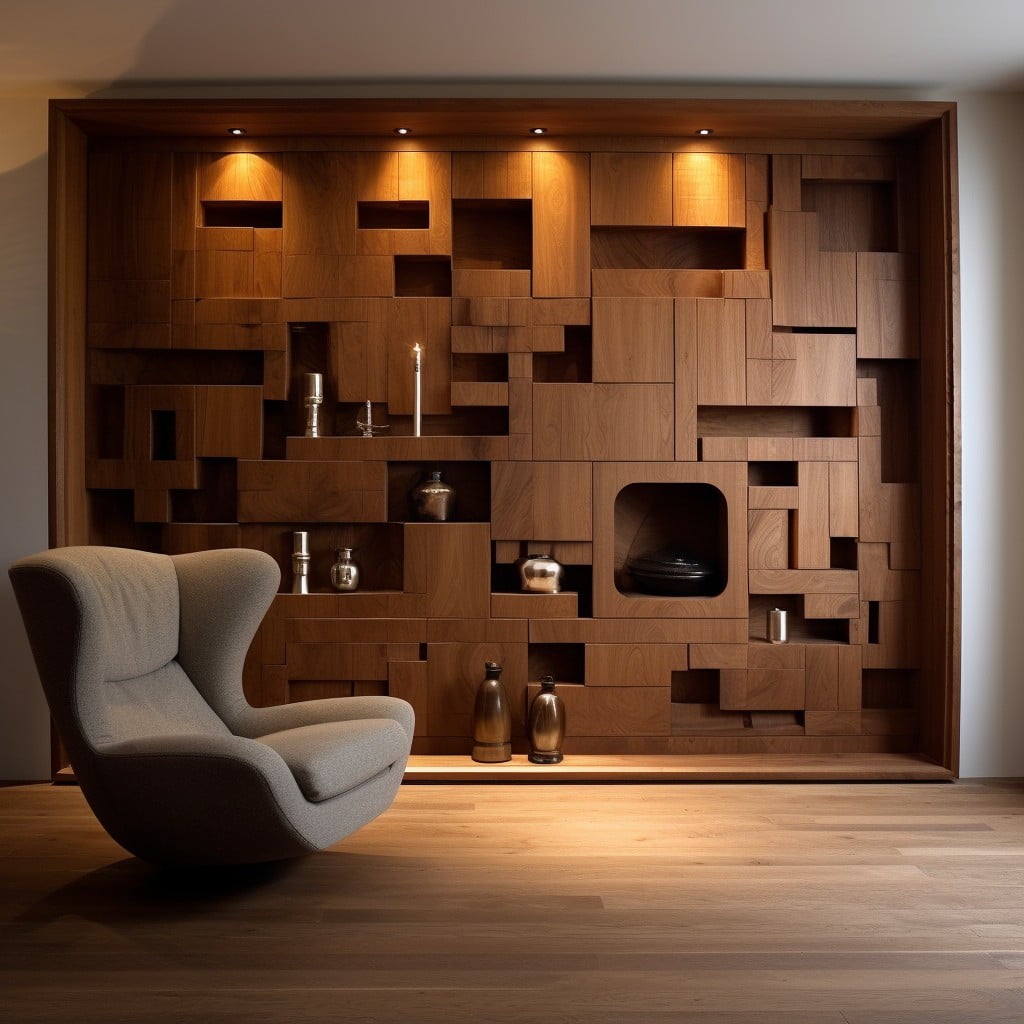
Creating niches in a wooden wall is an exceptional way to add depth and functionality. They can serve as a built-in shelving unit for displaying art, books or other decor pieces. These cubby-like spaces offer an airy, roomy feel.
Key points to consider when implementing this:
- 1. Identify a Suitable Wall: A wall that is free of plumbing or wiring to ensure a hassle-free installation process. Confirm this using a stud finder.
- 2. Decide on the Scale: Smaller niches for displaying delicate items like sculptures or larger ones for books and vases. Consider the items you wish to display.
- 3. Opt for Conformity: Ensuring uniformity in the size and spacing of the niches will enhance the aesthetic appeal.
- 4. Final Touches: Opt for a finish in sync with the room’s overall décor, varnish, or paint to achieve the desired look. A soft lighting inside the niches can also be considered for a unique appeal.
Wall-mounted Wooden Shelves
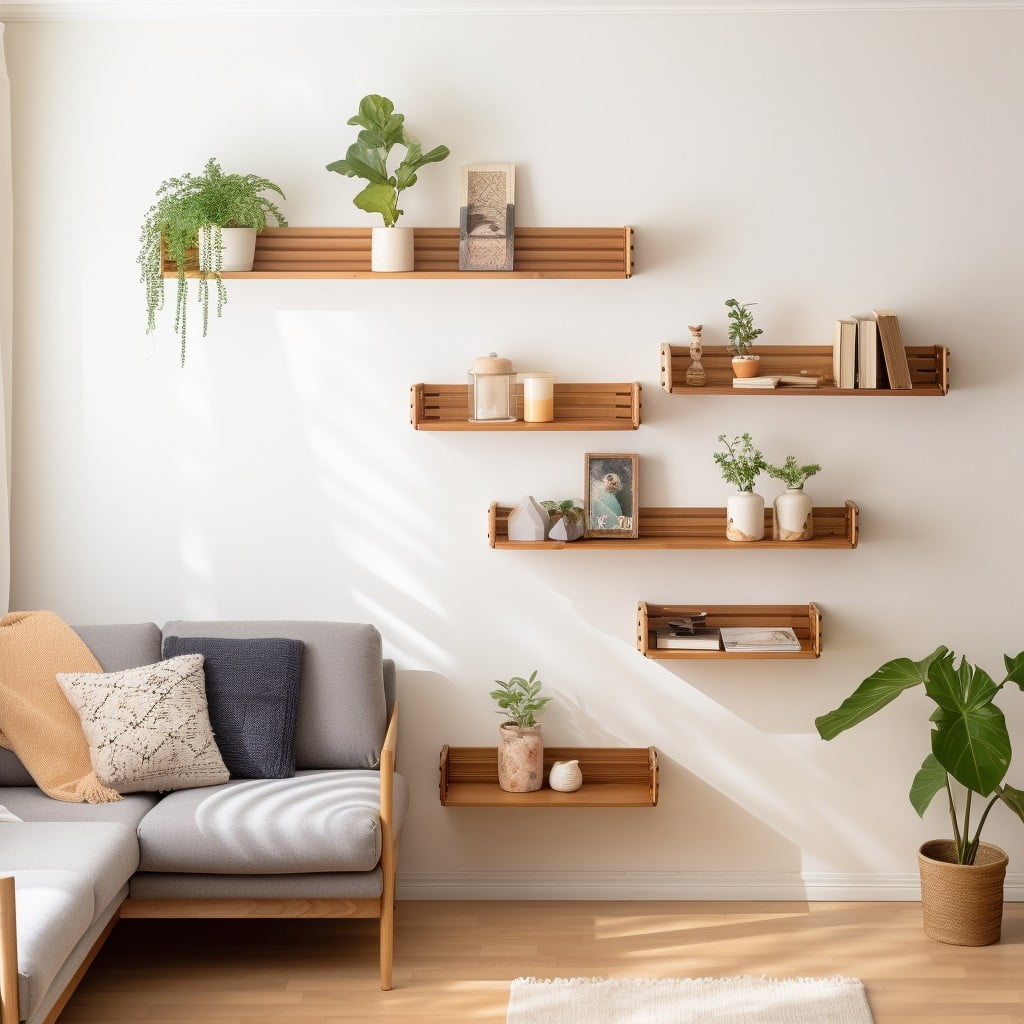
Harnessing the vertical space, these installations offer a mix of aesthetics and functionality, turning bare walls into captivating displays. Not limited to books or decor, customized shelves can serve as unique art pieces themselves with the right design and alignment.
Key points are:
- Versatility: Choice of solid, reclaimed or composite wood can complement various interior styles, with possibilities ranging from rustic to modern.
- Design: Float, bracket or crate – delve into myriad of designs that cater to space and weight requirements.
- Arrangement: Stagger, cluster or align – each approach configures a distinctive mood and visual interest.
- Technological innovations: Explore options such as built-in LED lights for dramatic effect, or hidden brackets for a minimalistic look.
- Decor rule: Maintain balance and harmony while displaying items. Consider proportions, contrasting textures, and hues.
- Sustainability: Consider sustainably sourced wood or reclaimed pieces to mitigate environmental impact.
Chevron Patterned Wood Wall
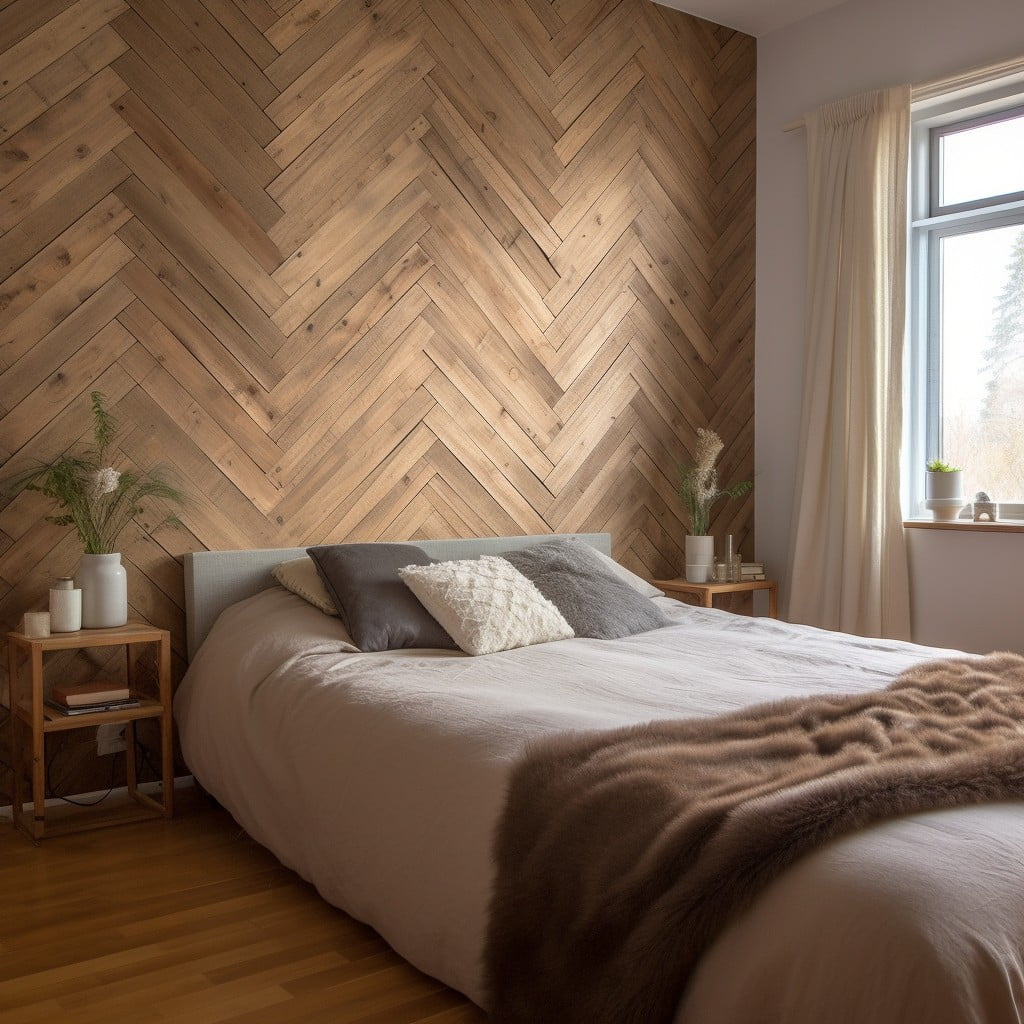
Creating a chevron pattern on your wood wall adds equal parts sophistication and style. To achieve this design, start by selecting planks of equal width. It’s important to make sure they are cut at an exact 45-degree angle for a seamless combination.
Key Points:
- Variation: Apply the chevron pattern vertically or horizontally to create visual interest. It can cover the entire wall or just a part to serve as an accent.
- Material: Reclaimed lumber, fresh timber, or even wood-look tiles can be used to implement the pattern.
- Color: Natural wood adds warmth, staining elevates elegance, while painting allows customization to align with your overall style. Feel free to be adventurous with colors, the chevron pattern permits it.
- Lighting: Proper lighting emphasizes the chevron pattern’s depth and rhythm. Install light fixtures strategically for the best result.
- Installation: Engage an expert if unsure about the DIY route. A well-executed chevron pattern is worth the investment.
Herringbone Wood Wall Design
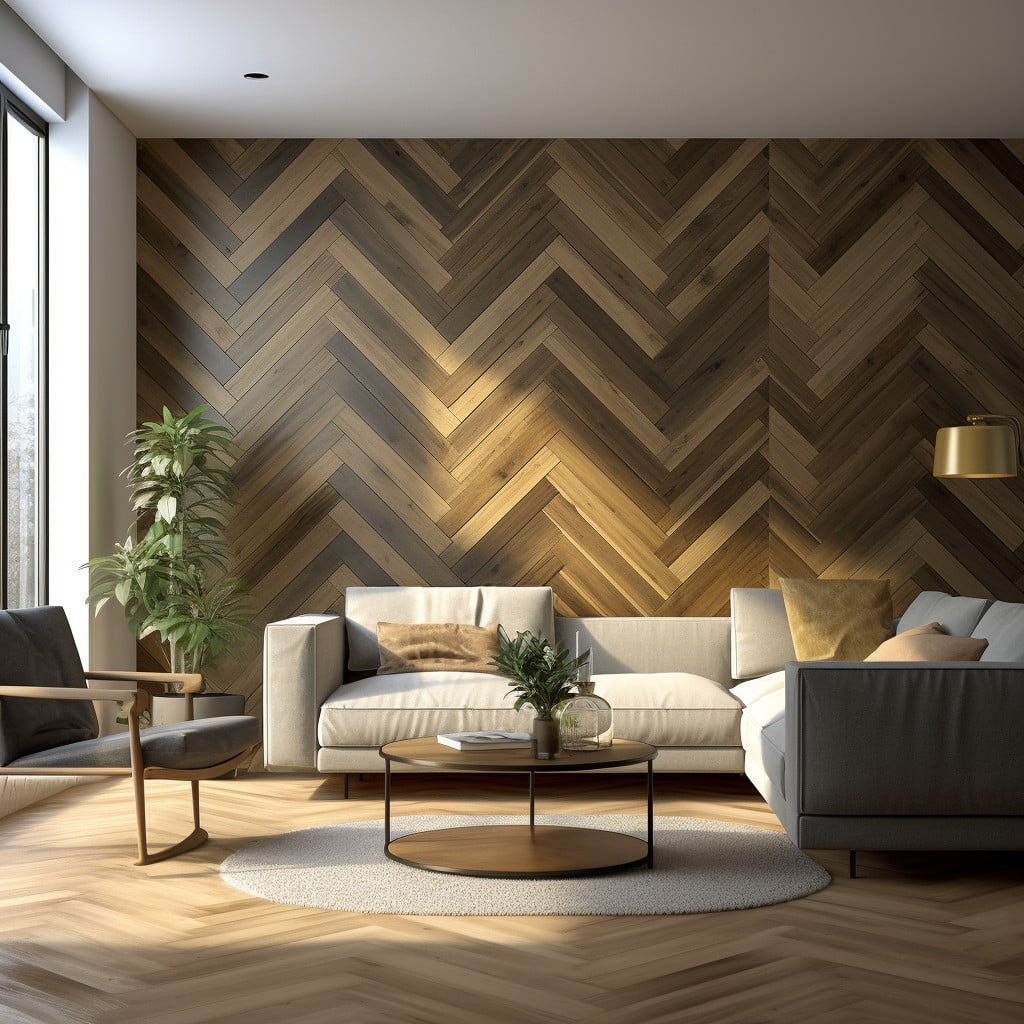
Herringbone wall design embraces an interlocking pattern of wood planks that meet at right angles, creating a directionally dynamic aesthetic. Ideal for any room, it injects sophistication and design finesse.
Here are the key elements for understanding and implementing this design:
- Pattern: The crisscross arrangement distinctive to herringbone offers visual interest and dimension.
- Material: Softwood, hardwood, or reclaimed timber can be used. Each offers different textures and colors.
- Installation: DIY or professional installation are options. While it’s more complex than other wood wall designs, attentiveness to pattern consistency will yield splendid results.
- Finish: Depending on the room and preferred aesthetic, opt for paint, varnish, or lacquer.
- Maintenance: Regular dusting and occasional deep-cleaning maintain the look.
The herringbone wood wall is both a design and functional marvel, making it a perfect choice for your modern, elegant home interiors.
Wooden Grid Wall

Adopting a visual charm and a geometric aesthetic, the wooden grid wall is a unique decorative option that offers both style and functionality. Its design is typically set up in a crisscross or grid-like pattern, with square or rectangular sections providing distinct spaces for art or decor.
Key Points:
- Geometric Aesthetic: This concept revolves around simple yet bold geometrical structure, instilling a sense of elegance and sophistication in your room.
- Versatility: The wooden grid wall acts as a blank canvas. Whether you choose to fill it with artistic elements, books, plants, or leave it minimalist, the options are limitless.
- Easy Installation: This design consists of evenly spaced wooden slats attached horizontally and vertically directly on the wall, making it a DIY-friendly project.
- Material Types: Hardwoods or smooth softwoods, both can be used depending on the desired appearance and durability.
- Customizable: The grid dimensions, wood stain, and finish can be adjusted to match any interior style, making each installation unique.
Coastal Style Driftwood Wall
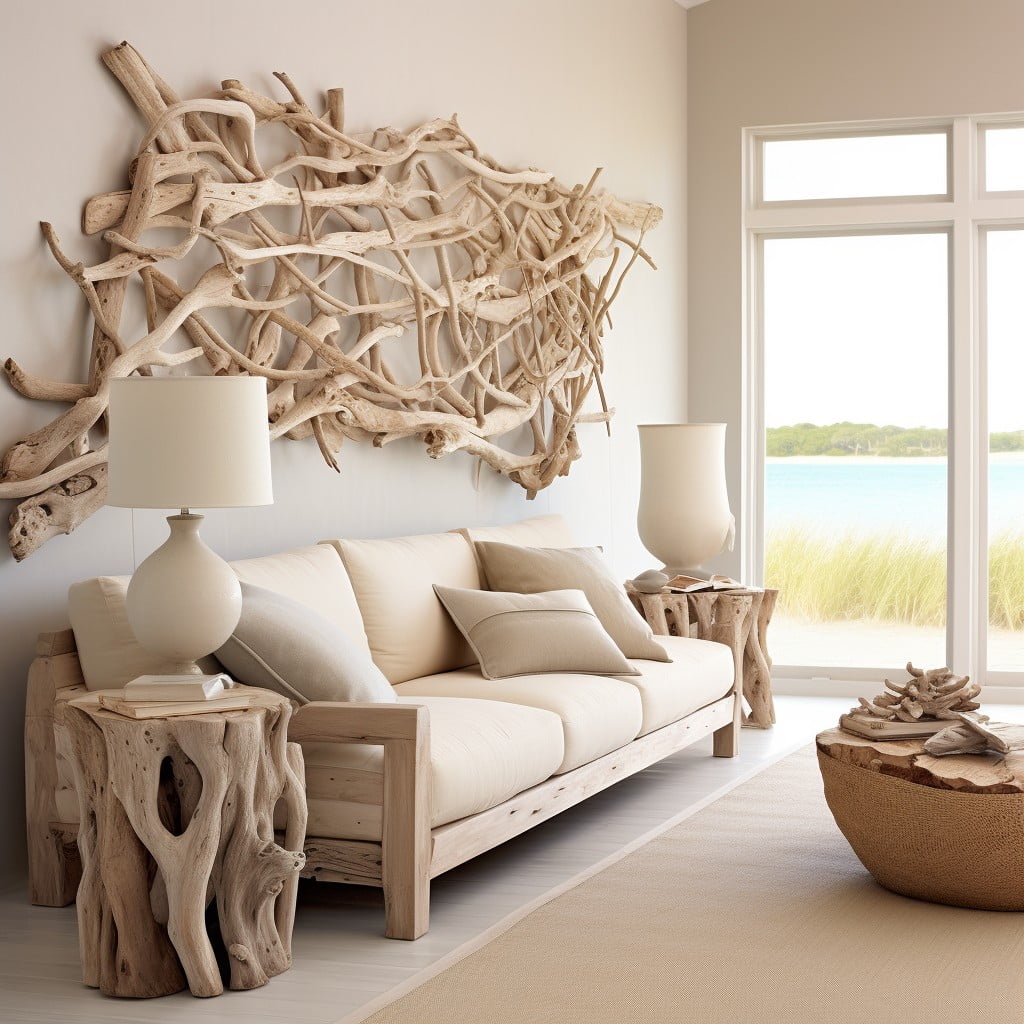
Utilizing the raw, weathered appeal of nature’s own artistry, the coastal style driftwood wall elevates your living area with its unique charm.
Displaying tones of soft grey, subtle sand, or sun-bleached white, the driftwood pieces interlink in an organic, spontaneous pattern, bringing to your domestic realm an echo of the sea’s rhythm and tranquility.
Key Points:
- Driftwood: Natural, raw, and weathered wood gathered from beaches, lending an organic touch.
- Unique Patterns: Strive for a random, non-uniform layout, mimicking the unpredictability of nature.
- Sea-Inspired Colors: Soft greys, muted sands, and bleached whites are characteristic of coastal style.
- Texture: The rugged surface of driftwood adds a tactile component to your wall design.
- Sustainability: This design utilizes reclaimed materials, making it an eco-friendly choice.
Lattice Wood Wall Design
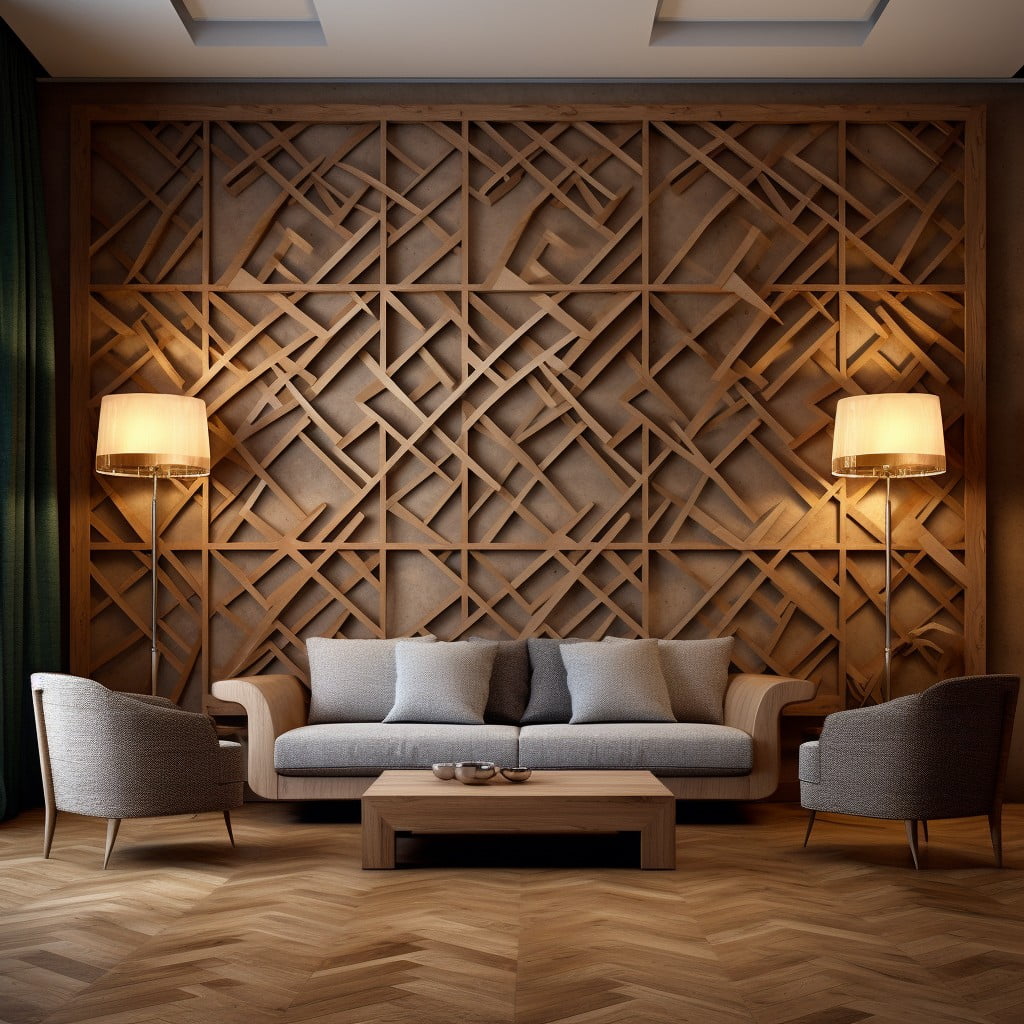
Lattice wood wall design subtly introduces dimension and character to a room. It incorporates artfully-designed crisscrossed panels, making the design both visually intriguing and structurally robust.
Key Aspects of Lattice Wood Wall Design:
- Visual Depth: The crisscross pattern creates a 3D effect, generating visual interest and adding depth to the space.
- Interplay of Light: The geometric gaps in the lattice structure play with light and shadows, providing a dynamic visual element that changes with the day.
- Versatility: The design complements various housing styles, from rustic to modern interiors.
- Durability: Its robust construction ensures longevity while providing a unique aesthetic to the room.
- Flexibility: This form of design accommodates other elements like mirrors or artwork, further enhancing the appeal of the living space.
Vertical Wood Plank Wall

A timeless yet modern design, vertical wood plank walls adds warmth and character to any room. This style typically utilizes thin, long planks fixed vertically to the wall, creating an elongated visual line, which can make low ceilings seem taller.
Key points to understand about vertical wood plank walls:
- Visual Impact: The vertical lines can make a wall seem higher, they draw the eyes upwards, creating an illusion of height and space.
- Versatility: The planks can be stained or painted, making them adaptable to any decor style.
- Installation Ease: The use of lightweight, easy-to-install tongue and groove planks make this a popular DIY project.
- Textural Interest: The grain and knots in the wood injects a natural, tactile appeal to the interiors.
- Sustainability: Depending on the type of the plank used, this can be a highly sustainable choice.
Whether you opt to cover an entire room or choose a feature wall, vertical plank walls bring dimension and architectural interest, elevating the overall aesthetic.
Painted Wood Block Wall

Painted wood block walls can bring a playful, artistic note to any space. Here are some key points to remember when creating this unique design:
- Select Your Wood: Choose durable species like oak or maple; their tight grain patterns will stand up to paint and everyday wear-and-tear.
- Plan Your Pattern: Consider size, shape, and placement for each block. Consistency can lead to a sophisticated look, while mixing it up, can yield something dynamic and hip.
- Prep the Blocks: Sand the surface smooth for best paint adherence. You might also consider priming the wood blocks for a cleaner, truer color finish.
- Paint: Use quality paint to ensure long-lasting results. Be adventurous with color—blocks can be all one hue, create an ombre effect, or a wildly colorful collection.
- Installation: Whether using nails, screws, or adhesive, attach each wood block securely. Keep your planned pattern and line levels on point for a polished final look.
The painted wood block wall can truly be a DIY project within your grasp. It’s about applying elementary carpentry skills paired with your creative vision to achieve a distinct wall design personalizing your space.
COMBINE Wood and Stone Wall
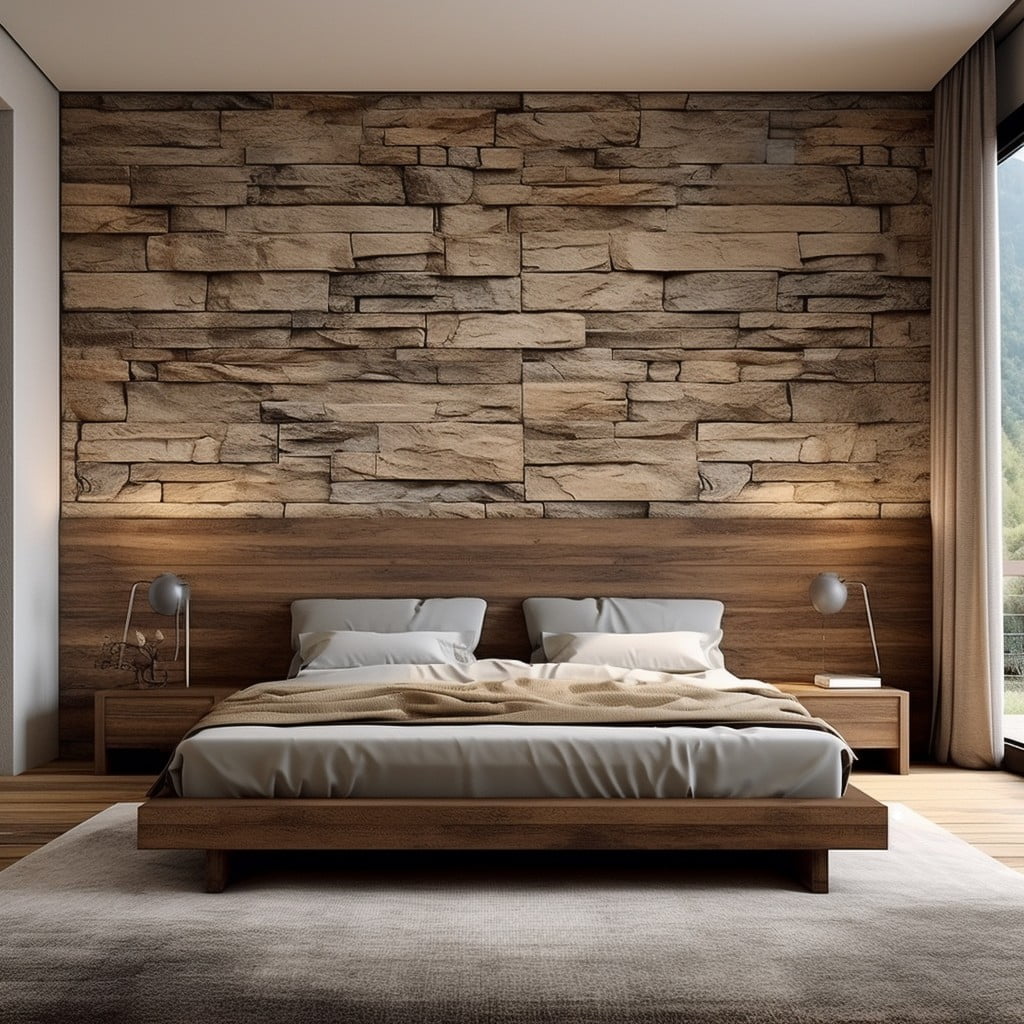
Effortlessly merging the rugged charm of stone with the organic warmth of wood results in a sophisticated and natural appearance.
To achieve this:
1. Select a layout: Choose to either alternate between wood and stone or have one dominate with the other as an accent.
2. Choice of stone: Limestone, slate, and granite among others, provide various hues and textures.
3. Picking wood: Be it raw, varnished, or painted, the type is pivotal in setting the room’s tone.
4. Balance: Avoid over saturating one material – a varied ratio creates visual interest.
Implementing these elements ensures a harmonious blend of the two natural materials, creating a timeless aesthetic.
Glazed Timber Wall
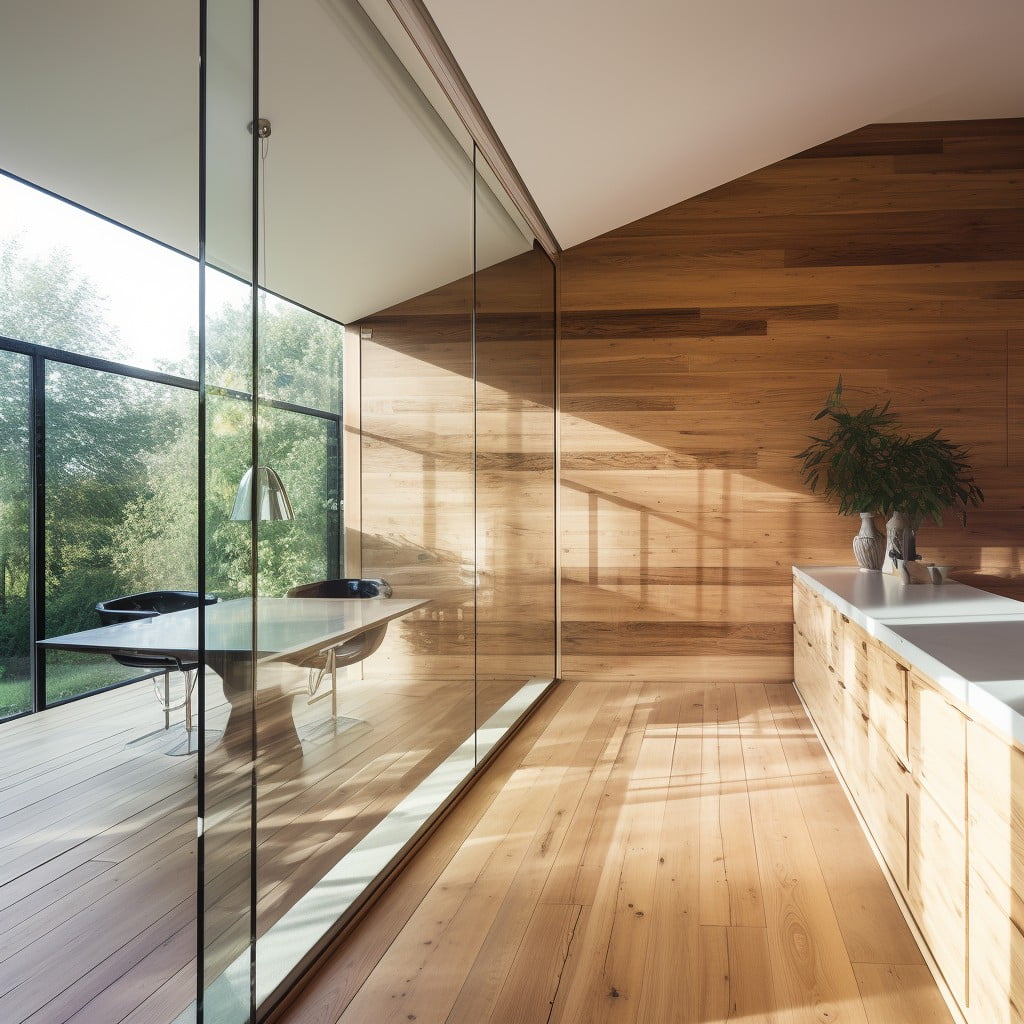
Glazed timber is renowned for its glossy finish which adds a touch of sophistication and elegance to any room. The process involves applying a layer of hard-wearing, transparent gloss over the timber, which not only enhances its aesthetic appeal, but also increases its longevity.
Key points to consider when integrating glazed timber walls into your home decor:
- 1. Pre-Finished or Site-Finished: Decide between prefinished glazed timber, ready to install, or unfinished wood that can be customized and glazed on-site.
- 2. Types of Glaze: Choose between oil or water-based glazes. Water-based glazes are environment-friendly and easy to clean while oil-based glazes provide a more durable, glossy finish.
- 3. Color Choices: Glazes come in an array of hues. Clear glaze allows the natural wood color to shine through, while tinted glazes can add a touch of color.
- 4. Maintenance: Regular dusting and occasional re-glazing are necessary to maintain the immaculate look.
- 5. Professional Assistance: Glazing is a skilled task. Engage professionals for a flawless, high-quality finish.
Switching to glazed timber walls could be your ticket to a stylish, modernized home.
Suspended Wooden Cubes Wall
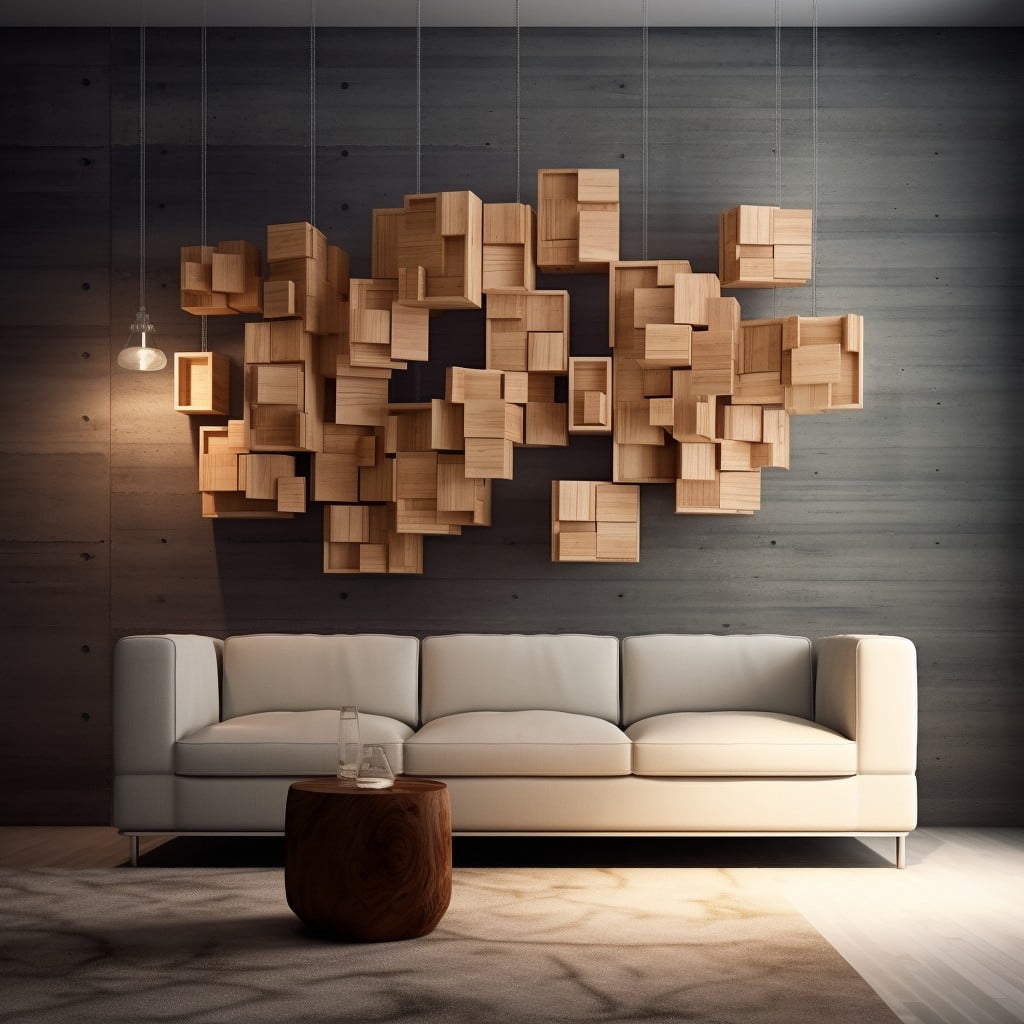
Suspended wooden cubes warrant a 3D element to your interiors. These dynamic structures can truly transform the ambience of the room, lending a modern yet rustic feel. Install them individually or cluster together for a striking effect, either way, these cubes never fail to impress.
Key Points:
- Customizability: Can be tailored in terms of size and color to match the interior setting.
- Unique Aesthetics: Cube’s three-dimensional appearance offers a unique visual detail.
- Versatile: Works well in any room, from living spaces to offices.
- Durable: Wood’s inherent strength ensures durability.
- Easy Installation: Can be installed with basic hardware tools.
- Storage Potential: Some designs allow using cubes as functional storage.
Continue exploring:




